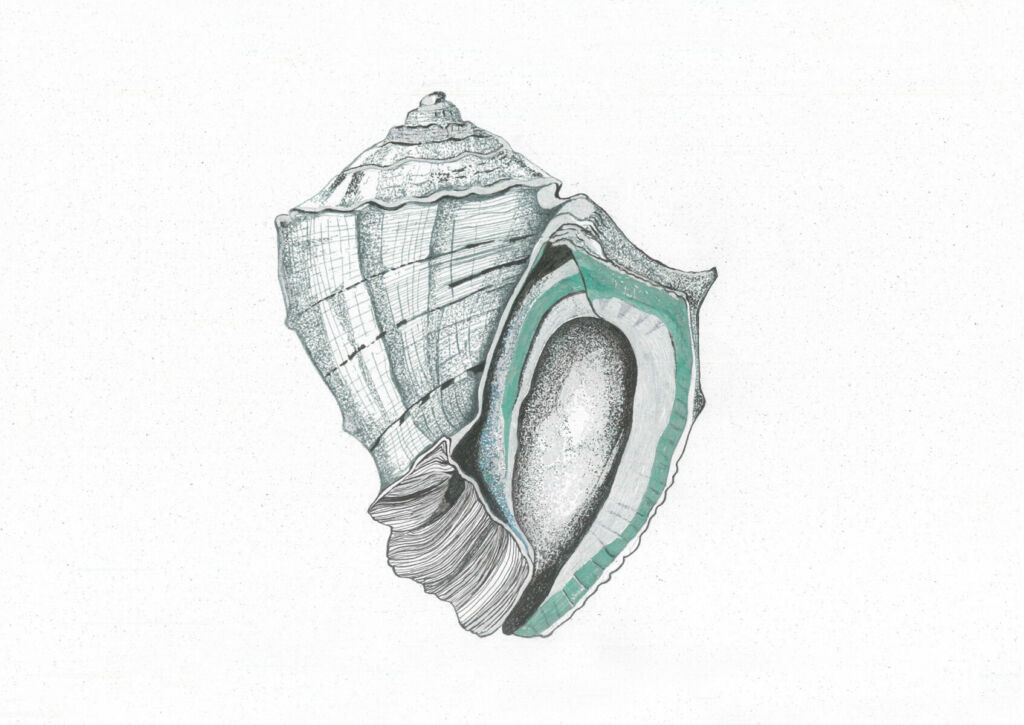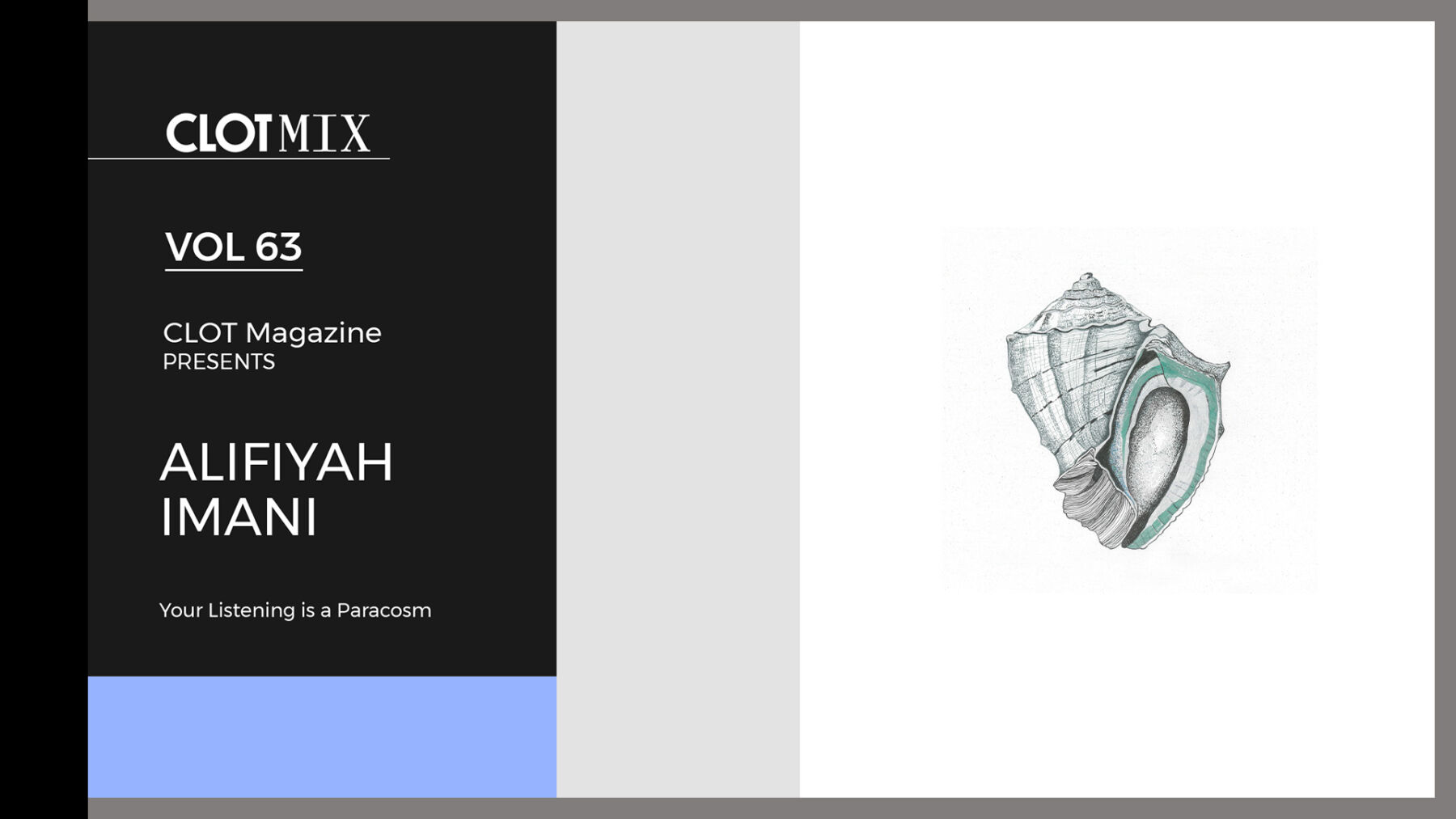Text by CLOT Magazine

The next mixtape comes from Alifiyah Imani, an interdisciplinary arts & media practitioner and writer. Imani combines multimedia arts and design, focusing on sound, curatorial research and practice. She enquires into our relationship with space, the workings of our cultures and auditory subcultures.
Last June, Imani premiered at Distant Gallery, an online solo exhibition, Your Listening is a Paracosm, a show that shifts perceptual perspectives through sound and ritual, drawings and prompts. Your Listening is a Paracosm, unfolds as an experiment for the web and permeates through radio transmissions. We read in the statement.
Imani told us that an important aspect of Indian classical music training is practising with the tanpura, a full-bodied stringed instrument that creates a repetitive drone. While practising and tuning the tanpura, the daily ritual of attuning myself to the drone as a sonic companion and as a practice of embodied listening and improvising has been significant for me to understand the structure of sound itself. She said.
Taking this show as an inspiration Alifiyah Imani has prepared a mixtape for us that intends to explore the sound pieces from the exhibition as an extended listening or long-form mix. Imani spent much of this time in her home studio layering field recordings, experimenting with the drone sound of the Tanpura, and improvising with other instruments like the Strumok and overtone flute: It’s about different kinds of attention processes, tuning, and studying forms derived from sound. While drone-based and contemplative, it moves between textures, harmony, polyphony of colours, and moments that emerge in nature and improvised music.
Your interest lies in the awareness and relationality of sound, internal and external structures, and experimentation with form concepts, such as atmospheric dimensions, drone, texture, sonic movements, and space, inspired by the quantum listening philosophy. How did you translate these thoughts into sounds?
A few years ago, I was researching methods for toning and training the voice and became particularly drawn to overtone singing. I first experienced it while participating in a singing group. The slow transitions between each vowel sound and the colour contained within a fundamental frequency or a single sound pitch were initially more challenging for me to grasp as a phenomenon. With continual practice, I started distinctly listening to the overtones in my voice.
The more I became aware of this character of sound, it gave me this innate access to my voice and the ability to be moved by it and experience a sense of complete freedom. Later, I also started training in Carnatic Singing. An important aspect of Indian classical music training is practising with the tanpura, a full-bodied stringed instrument that creates a repetitive drone. What was fascinating for me is that the strings of the tanpura act as a prism for overtones, and the resonating sound is inseparable from the structure of any raga, which can be thought of as a collection of ascending and descending pitches comparable to a scale or mode in Western music.
While practising and tuning the tanpura, the daily ritual of attuning myself to the drone as a sonic companion and as a practice of embodied listening and improvising has been significant for me to understand the structure of sound itself. It opened up another perspective on my obsession with overtones, as the foundation of an ancient tuning system, and this interconnectedness of breath control and body awareness that I had discovered with the voice. I also found it fascinating that overtones are part of the natural laws of vibration and nature. For me, it evolved into a method of consciously exploring sound sources with apparent natural overtones and connecting them across spatial and lived contexts as an inspiration for deep listening.
Do you find yourself using a particular equipment that helps you translate your ideas?
I have a Zoom H4n handy recorder that I use for field recordings. I don’t tend to translate ideas from studio space. Field recording outdoors and listening to sources in nature have always been part of my practice. With field recording, I almost feel I am experiencing every season.
This wealth of sonic information is contained within certain listening experiences in nature. As a listener, you become aware of this melodic aspect of repetition and variation through which environmental patterns become perceptible. My experiments with long-form listening often involve rearranging recorded layers of nature sounds with improvised acoustic instruments like the Tanpura, the overtone flute, and ambient midi samples. In a way, engaging in this extended listening through long-form, where you commit to a kind of storytelling beyond the concept of a produced “track”, invites a slow immersion into the raw process.
This is an exciting direction for me. With this particular interest, I’ve also been producing solo and collaborative radio pieces, using this medium for sharing sound discoveries and playing with composing formats where arriving at a form, a presence, or an atmosphere can leave a sense of intimacy on the listener.
In your sonic research work, your interest lies in making and sounding instruments with your partner Vlad. How does your background complement each other?
We first met while working together at an artist residency institute in Budapest that develops works with spatial sound in a 4DSOUND studio. Vlad was the studio’s go-to guy, who was fast and could address technological issues. With an engineering-maker mindset, his approach is very hands-on and logic-driven.
Vlad is good with electronics, materials, circuitry, and programming and can work with them in many different contexts. He is also musically trained for the flute and can improvise with many other instruments. My background is in design and media arts, and my artistic practice is situated at the intersections of disciplines and different mediums, with a special focus on sound. I work with field recordings, ambient stretches, radio art, video, drawing, and text.
While my overall approach to sound is more experimental, I am also training myself musically within specific interests I have developed in the last few years. Vlad’s presence has been very instrumental in this process. I can always rely on a second pair of ears, a partner with whom I can bounce ideas off, and troubleshooting technical details, which is not my forte. Between us, we can cover a lot of ground to realise a vision, and we also enjoy this process of creating together and supporting each other in our practices.
Our work as the “Sono Sensing” collective began by creating a radio show with field recordings and improvised jams with the instruments we had collected. Now we are more into building instruments together out of scrap. We gather a lot of random stuff left on the streets in Berlin, where we currently live, and enjoy repurposing some of the things we find to make experimental sound objects.
You have the online solo show Your Listening is a Paracosm as part of the artist-run platform Distant Gallery which premiered on June 26, 2023. The show features a collection of poetic listening scores, texts, and illustrations; you are simultaneously the curator and the artist participating. How did you approach both roles as a curator and artist?
The online exhibition is hosted on common.garden and there are different ways that you can work with this platform to create a sense of liveness, movement, and interaction to display artworks and media. You can also meet people who enter the exhibition at the same time as you. I wanted to know how I could work with its possibilities to create an intimate experience of sound works.
Drawings influenced my creative process for the exhibition, and I wanted to work with them as these living guides, signs, and symbols into what I hoped could be a ritual that could transform listeners somehow. So, viewing an artwork requires more than just looking at it; it also requires being observant and attentive towards listening. It’s more complicated to do in an internet environment where you are continuously distracted. It’s also something that I thought about a lot.
How do you move around this garden? How do the visual and sonic elements transcribe a state of mind and hold your attention? In my personal and artistic practice, I have explored concepts of mind, meditation, breath, consciousness, and its possibilities through relational listening. To connect with this consciously, I needed to cultivate the attention process through the encounters’ design and interaction.
The experience of the show required a lot of work at the back end in terms of coding and prototyping to create these fluid, alluring, and dream-like details of what I call a paracosm. Additionally, it makes sense that you are responsible for curating your work. I started with one goal in mind, but there’s a good chance it may have turned out differently, so you can keep experimenting with the structure.
You said that the quantum listening philosophy inspires you. For those unfamiliar with the term, please expand more on this. What do you find so inspirational about quantum listening philosophy?
Quantum listening is an extension of the deep listening philosophy. Both terms come from the late composer, accordionist, and author Pauline Oliveros. I particularly like how she describes Quantum Listening as attention to a point—all or nothing focus, which changes that point forever. She also says, The perceiver and the perceived co-create through the listening effect. All sounds are included in the field. This creates potential, cultivates surprises, opens the imagination and approaches, and even plunges over the edges of perception into the mystery of the universe predicted by quantum field theory.
The inspiration comes from considering listening not just an ordinary experience of reality or a theoretical framework but as this access or space inside the body where your consciousness grasps the process of change. I think a lot about form and formlessness—these moments where you can be outside yourself and what you have been conditioned to be. So, listening is a constant discovery you can cultivate and hone to uncover layers of and beyond the self.






